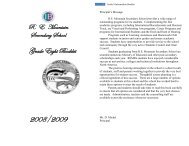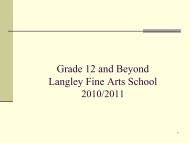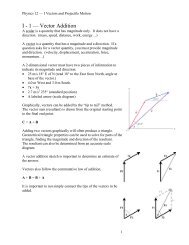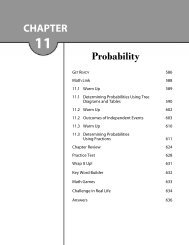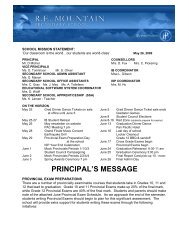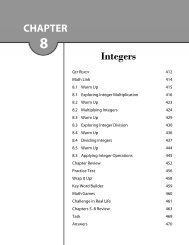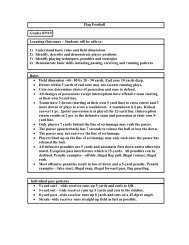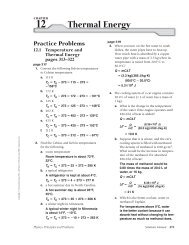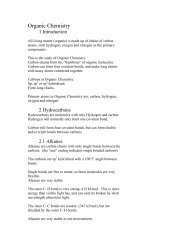Physics Solutions Manual
Physics Solutions Manual
Physics Solutions Manual
Create successful ePaper yourself
Turn your PDF publications into a flip-book with our unique Google optimized e-Paper software.
Chapter 24 continued<br />
7. A student makes a magnet by winding wire<br />
around a nail and connecting it to a battery,<br />
as shown in Figure 24-13. Which end of<br />
the nail, the pointed end or the head, will<br />
be the north pole?<br />
■ Figure 24-13<br />
the pointed end<br />
<br />
8. You have a spool of wire, a glass rod, an<br />
iron rod, and an aluminum rod. Which rod<br />
should you use to make an electromagnet<br />
to pick up steel objects? Explain.<br />
Use the iron rod. Iron would be attracted<br />
to a permanent magnet and take on properties<br />
of a magnet, whereas aluminum or<br />
glass would not. This effect would support<br />
the magnetic field in the wire coil and<br />
thus make the strongest electromagnet.<br />
9. The electromagnet in problem 8 works well,<br />
but you decide that you would like to make its<br />
strength adjustable by using a potentiometer<br />
as a variable resistor. Is this possible? Explain.<br />
Yes. Connect the potentiometer in<br />
series with the power supply and the<br />
coil. Adjusting the potentiometer for<br />
more resistance will decrease the current<br />
flow and the strength of the field.<br />
Section Review<br />
24.1 Magnets: Permanent and<br />
Temporary<br />
pages 643–651<br />
page 651<br />
10. Magnetic Fields Is a magnetic field real, or<br />
is it just a means of scientific modeling?<br />
Field lines are not real. The field is real.<br />
11. Magnetic Forces Identify some magnetic<br />
forces around you. How could you demonstrate<br />
the effects of those forces?<br />
Student answers may vary. Answers<br />
could include magnets on a refrigerator<br />
and Earth’s magnetic field. The effects<br />
of these forces can be demonstrated by<br />
bringing another magnet, or a material<br />
that can be magnetized, nearby.<br />
12. Magnetic Fields A current-carrying wire is<br />
passed through a card on which iron filings<br />
are sprinkled. The filings show the magnetic<br />
field around the wire. A second wire is close<br />
to and parallel to the first wire. There is an<br />
identical current in the second wire. If the<br />
two currents are in the same direction, how<br />
will the first magnetic field be affected?<br />
How will it be affected if the two currents<br />
are in opposite directions?<br />
It would be approximately twice as<br />
large; it would be approximately zero.<br />
13. Direction of a Magnetic Field Describe<br />
the right-hand rule used to determine the<br />
direction of a magnetic field around a<br />
straight, current-carrying wire.<br />
If you grasp the wire with your right hand,<br />
with your thumb pointing in the direction<br />
of the conventional current, your fingers<br />
curl in the direction of the field.<br />
14. Electromagnets A glass sheet is placed<br />
over an active electromagnet, and iron filings<br />
sprinkled on the sheet create a pattern<br />
on it. If this experiment is repeated with the<br />
polarity of the power supply reversed, what<br />
observable differences will result? Explain.<br />
None. The filings would show the same<br />
field pattern but a compass would show<br />
the magnetic polarity reversal.<br />
15. Critical Thinking Imagine a toy containing<br />
two parallel, horizontal metal rods, one<br />
above the other. The top rod is free to move<br />
up and down.<br />
a. The top rod floats above the lower one. If<br />
the top rod’s direction is reversed, however,<br />
it falls down onto the lower rod. Explain<br />
why the rods could behave in this way.<br />
The metal rods could be magnets<br />
with their axes parallel. If the top<br />
486 <strong>Solutions</strong> <strong>Manual</strong> <strong>Physics</strong>: Principles and Problems<br />
Copyright © Glencoe/McGraw-Hill, a division of The McGraw-Hill Companies, Inc.





